
Bryozoa are a phylum of aquatic invertebrate animals, nearly all forming sedentary colonies. Typically about 0.5 millimetres long, they are filter feeders that sieve food particles out of the water using a retractable lophophore, a "crown" of tentacles lined with cilia. Most marine species live in tropical waters, but a few occur in oceanic trenches, and others are found in polar waters. One class lives only in freshwater environments, and a few members of a mostly marine class prefer brackish water. 5869 living species are known. One genus is solitary and the rest are colonial.

Cypriniformes is an order of ray-finned fish, including the carps, minnows, loaches, and relatives. This order contains 11-12, although some authorities have designated as many as 23, families over 400 genera, and more than 4,250 species, with new species being described every few months or so, and new genera being recognized frequently. They are most diverse in southeastern Asia, and are entirely absent from Australia and South America. At 112 years old, the longest-lived cypriniform fish documented is the bigmouth buffalo.

Adeona is a genus of bryozoans in the family Adeonidae. A typical example is the Australian species Adeona cellulosa that forms large colonies with bifoliate sheets containing numerous holes (fenestrae).

A population bottleneck or genetic bottleneck is a sharp reduction in the size of a population due to environmental events such as famines, earthquakes, floods, fires, disease, and droughts or human activities such as specicide and human population planning. Such events can reduce the variation in the gene pool of a population; thereafter, a smaller population, with a smaller genetic diversity, remains to pass on genes to future generations of offspring through sexual reproduction. Genetic diversity remains lower, increasing only when gene flow from another population occurs or very slowly increasing with time as random mutations occur. This results in a reduction in the robustness of the population and in its ability to adapt to and survive selecting environmental changes, such as climate change or a shift in available resources. Alternatively, if survivors of the bottleneck are the individuals with the greatest genetic fitness, the frequency of the fitter genes within the gene pool is increased, while the pool itself is reduced.

Entoprocta, whose name means "rectum/anus inside", or Kamptozoa, is a phylum of mostly sessile aquatic animals, ranging from 0.1 to 7 millimetres long. Mature individuals are goblet-shaped, on relatively long stalks. They have a "crown" of solid tentacles whose cilia generate water currents that draw food particles towards the mouth, and both the mouth and anus lie inside the "crown". The superficially similar Bryozoa (Ectoprocta) have the anus outside a "crown" of hollow tentacles. Most families of entoprocts are colonial, and all but 2 of the 150 species are marine. A few solitary species can move slowly.
Phylogeography is the study of the historical processes that may be responsible for the past to present geographic distributions of genealogical lineages. This is accomplished by considering the geographic distribution of individuals in light of genetics, particularly population genetics.

Cheilostomatida is an order of Bryozoa in the class Gymnolaemata.

The Eurasian otter, also known as the European otter, Eurasian river otter, common otter, and Old World otter, is a semiaquatic mammal native to Eurasia. The most widely distributed member of the otter subfamily (Lutrinae) of the weasel family (Mustelidae), it is found in the waterways and coasts of Europe, many parts of Asia, and parts of northern Africa. The Eurasian otter has a diet mainly of fish, and is strongly territorial. It is endangered in some parts of its range, but is recovering in others.
Tetracapsuloides bryosalmonae is a myxozoan parasite of salmonid fish. It is the only species currently recognized in the monotypic genus Tetracapsuloides. It is the cause of Proliferative Kidney Disease (PKD), one of the most serious parasitic diseases of salmonid populations in Europe and North America that can result in losses of up to 90% in infected populations.
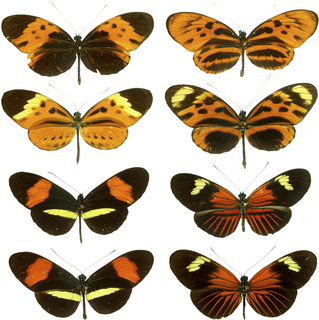
In biology, a species complex is a group of closely related organisms that are so similar in appearance that the boundaries between them are often unclear. Terms that are sometimes used synonymously but have more precise meanings are cryptic species for two or more species hidden under one species name, sibling species for two cryptic species that are each other's closest relative, and species flock for a group of closely related species that live in the same habitat. As informal taxonomic ranks, species group, species aggregate, macrospecies, and superspecies are also in use.

Symbiodinium is a genus of dinoflagellates that encompasses the largest and most prevalent group of endosymbiotic dinoflagellates known. These unicellular algae commonly reside in the endoderm of tropical cnidarians such as corals, sea anemones, and jellyfish, where the products of their photosynthetic processing are exchanged in the host for inorganic molecules. They are also harbored by various species of demosponges, flatworms, mollusks such as the giant clams, foraminifera (soritids), and some ciliates. Generally, these dinoflagellates enter the host cell through phagocytosis, persist as intracellular symbionts, reproduce, and disperse to the environment. The exception is in most mollusks, where these symbionts are intercellular. Cnidarians that are associated with Symbiodinium occur mostly in warm oligotrophic (nutrient-poor), marine environments where they are often the dominant constituents of benthic communities. These dinoflagellates are therefore among the most abundant eukaryotic microbes found in coral reef ecosystems.

A zooid or zoöid is a single animal that is part of a colonial animal. This lifestyle has been adopted by animals from separate unrelated taxa. Zooids are multicellular; their structure is similar to that of other solitary animals. The zooids can either be directly connected by tissue or share a common exoskeleton. The colonial organism as a whole is called a zoon, plural zoa.
Genetic monitoring is the use of molecular markers to (i) identify individuals, species or populations, or (ii) to quantify changes in population genetic metrics over time. Genetic monitoring can thus be used to detect changes in species abundance and/or diversity, and has become an important tool in both conservation and livestock management. The types of molecular markers used to monitor populations are most commonly mitochondrial, microsatellites or single-nucleotide polymorphisms (SNPs), while earlier studies also used allozyme data. Species gene diversity is also recognized as an important biodiversity metric for implementation of the Convention on Biological Diversity.

Flustra foliacea is a species of bryozoans found in the northern Atlantic Ocean. It is a colonial animal that is frequently mistaken for a seaweed. Colonies begin as encrusting mats, and only produce loose fronds after their first year of growth. They may reach 20 cm (8 in) long, and smell like lemons. Its microscopic structure was examined by Robert Hooke and illustrated in his 1665 work Micrographia.
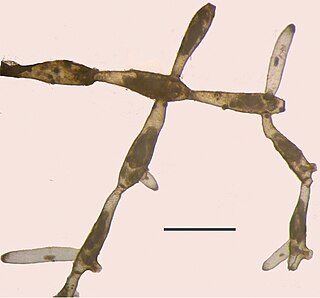
Paludicella articulata is a species of freshwater moss animal in the genus Paludicella.
Conopeum seurati is a species of colonial bryozoan in the order Cheilostomatida. It is native to the northeastern Atlantic Ocean, the North Sea and the Mediterranean Sea. This species has been introduced to New Zealand and Florida.
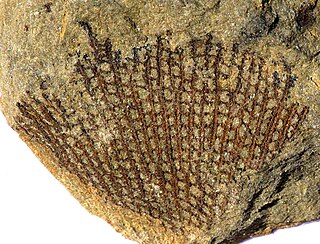
Fenestella is a genus of bryozoans or moss animals, forming fan–shaped colonies with a netted appearance. It is known from the Middle Ordovician to the early Upper Triassic (Carnian), reaching its largest diversity during the Carboniferous. Many hundreds of species have been described from marine sediments all over the world.
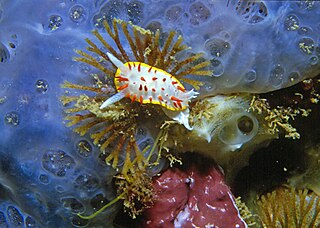
Bugula neritina is a cryptic species complex of sessile marine animal in the genus Bugula.
Callopora lineata is a species of colonial bryozoan in the family Calloporidae. It is found on rocky shores in the Atlantic Ocean and the Mediterranean Sea.
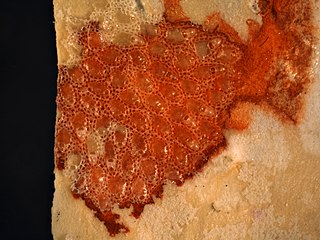
Chorizopora brongniartii is a species of bryozoan in the family Chorizoporidae. It is an encrusting bryozoan, the colonies forming spreading patches. It has a widespread distribution in tropical and temperate seas.















